
Board games are tabletop games that typically use pieces. These pieces are moved or placed on a pre-marked board and often include elements of table, card, role-playing, and miniatures games as well.

Backgammon is a two-player board game played with counters and dice on tables boards. It is the most widespread Western member of the large family of tables games, whose ancestors date back nearly 5,000 years to the regions of Mesopotamia and Persia. The earliest record of backgammon itself dates to 17th-century England, being descended from the 16th-century game of Irish.

Ludo is a strategy board game for two to four players, in which the players race their four tokens from start to finish according to the rolls of a single die. Like other cross and circle games, Ludo is derived from the Indian game Pachisi. The game and its variations are popular in many countries and under various names.

Monopoly is a multi-player economics-themed board game. In the game, players roll two dice to move around the game board, buying and trading properties and developing them with houses and hotels. Players collect rent from their opponents, aiming to drive them into bankruptcy. Money can also be gained or lost through Chance and Community Chest cards and tax squares. Players receive a stipend every time they pass "Go" and can end up in jail, from which they cannot move until they have met one of three conditions. House rules, hundreds of different editions, many spin-offs, and related media exist. Monopoly has become a part of international popular culture, having been licensed locally in more than 103 countries and printed in more than 37 languages. As of 2015, it was estimated that the game had sold 275 million copies worldwide.
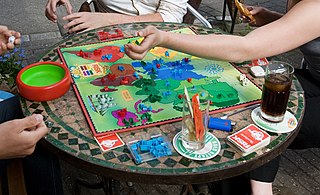
Risk is a strategy board game of diplomacy, conflict and conquest for two to six players. The standard version is played on a board depicting a political map of the world, divided into 42 territories, which are grouped into six continents. Turns rotate among players who control armies of playing pieces with which they attempt to capture territories from other players, with results determined by dice rolls. Players may form and dissolve alliances during the course of the game. The goal of the game is to occupy every territory on the board and, in doing so, eliminate the other players. The game can be lengthy, requiring several hours to multiple days to finish. European versions are structured so that each player has a limited "secret mission" objective that shortens the game.
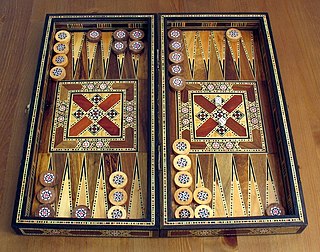
Tables games are a class of board game that includes backgammon and which are played on a tables board, typically with two rows of 12 vertical markings called points. Players roll dice to determine the movement of pieces. Tables games are among the oldest known board games, and many different varieties are played throughout the world. They are called 'tables' games because the boards consist of four quadrants or 'tables'. The vast majority are race games, the tables board representing a linear race track with start and finish points, the aim being to be first to the finish line, but the characteristic features that distinguish tables games from other race games are that they are two-player games using a large number of pieces, usually fifteen per player.

Tabula, meaning a plank or board, was a Greco-Roman board game for two players that has given its name to the tables family of games of which backgammon is a member.

Trouble is a board game in which players compete to be the first to send four pieces all the way around a board. Pieces are moved according to the roll of a die using a contained device called a "Pop-O-Matic". Trouble was developed by the Kohner Brothers and initially manufactured by Irwin Toy Ltd., later by Milton Bradley. The game was launched in America in 1965. The classic version is now marketed by Winning Moves Games USA. The gameplay, board, and concept is derivative of the Indian board game Ludo.

Parqués is the Colombian version of a board game in the cross and circle family. The game is described as a "random thinking" game: the moves depend on the roll of the dice but players must consider possible strategies before executing their move. The objective of the game is to advance all the pieces to the end. Once in the safety zone player can use 2 dice until they are one space away from home, where they will then just use one die.

Parcheesi is a brand-name American adaptation of the Indian cross and circle board game Pachisi, published by Parker Brothers and Winning Moves Games USA.

The Royal Game of Ur is a two-player strategy race board game of the tables family that was first played in ancient Mesopotamia during the early third millennium BC. The game was popular across the Middle East among people of all social strata and boards for playing it have been found at locations as far away from Mesopotamia as Crete and Sri Lanka. One board, held by the British Museum, is dated to c. 2600 – c. 2400 BC, making it one of the oldest game boards in the world.

Escape from Colditz is a board game produced by Gibsons Games of London in 1973 that simulates attempted escapes by Allied prisoners-of-war (POWs) from Oflag IV-C during World War II. Designed in part by a former POW who escaped from Colditz, the game was released during the first run of the popular television series Colditz, and the game likewise proved popular. Licensed editions were published by Parker Brothers and a number of other companies. The game proved especially popular in Spain, and resulted in a Spanish-language sequel.
Maharajah and the Sepoys, originally called Shatranj Diwana Shah and also known as the Mad King's Game and Maharajah chess, is a popular chess variant with different armies for White and Black. It was first played in the 19th century in India. It is a solved game with a forced win for Black.
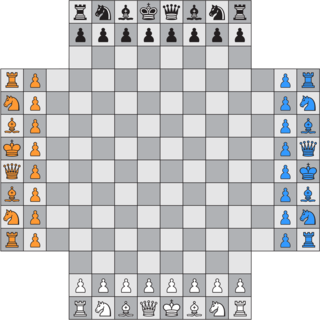
Four-player chess is a family of chess variants played with four people. The game features a special board typically made of a standard 8×8 square, with 3 rows of 8 cells each extending from each side, and requires two sets of differently colored pieces. The rules are similar to, but not the same as, regular chess. There are a variety of different rule variations; most variations, however, share a somewhat similar board and piece setup.
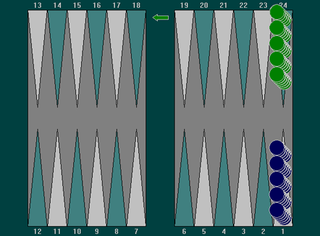
Plakoto (Πλακωτό) is a tables game for two players that is popular in Greece. The object is for the player to bring all 15 pieces around to his or her own home board and then bear them off. The player who bears off all 15 pieces first wins the game. This game is usually played along with two other variants, Févga and Pórtes. Together these three games are called Távli, and are played in sequence usually one after the other. Game is three, five or seven points. A Bulgarian version of Plakoto is known as Tapa and also as Tsillitón (Τσιλλιτόν), in Cyprus. Parlett places Plakoto in the same group as the popular mediaeval game of English, as well as the French games of Tieste and Impérial, the Italian game of Testa and Spanish Emperador.
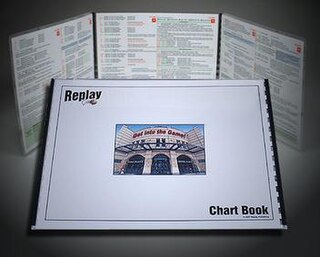
Replay Publishing is a game company based in Ohiopyle, Pennsylvania, that develops and publishes sports simulation games for the tabletop and computer. They currently produce Replay Baseball, Replay Basketball, and PC Replay Baseball. Competitors past and present include APBA, Diceball, Strat-O-Matic, Big League Manager, Design Depot, Negamco, Pursue the Pennant and Statis Pro Baseball.

Headache is a board game for in which the object is to land a playing piece on top of all opponents' pieces. Play moves in circles until one player has captured every other players' cones on the board and declared the winner. All players are welcome to occupy any space throughout the game, provided the die rolls allow, and there are eight spaces that serve as "safe" spots, where a cone resting on this space cannot be captured. Captured pieces are not sent back to start, but are permanently lost.

A game is a structured form of play, usually undertaken for entertainment or fun, and sometimes used as an educational tool. Many games are also considered to be work or art.
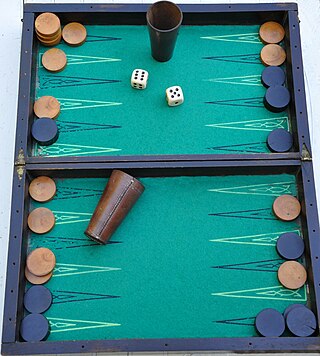
The following is a glossary of terms used in tables games, essentially games played on a Backgammon-type board. Terms in this glossary should not be game-specific, but applicable to a range of tables games.
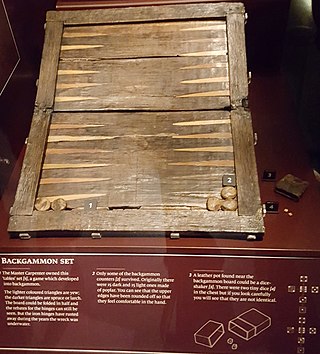
Irish or the Irish Game was an Anglo-Scottish tables game for two players that was popular from the 16th to the mid-18th centuries before being superseded by its derivative, the "faster paced" backgammon. In its day, Irish was "esteemed among the best games at Tables." Its name notwithstanding, Irish was one of the most international forms of tables games, the equivalent of French toutes tables, Italian tavole reale and Spanish todas tablas, the latter name first being used in the 1283 El Libro de los Juegos, a translation of Arabic manuscripts by the Toledo School of Translators.



















